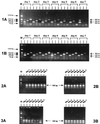Mailed, home-obtained urine specimens: a reliable screening approach for detecting asymptomatic Chlamydia trachomatis infections
- PMID: 10074512
- PMCID: PMC88635
- DOI: 10.1128/JCM.37.4.976-980.1999
Mailed, home-obtained urine specimens: a reliable screening approach for detecting asymptomatic Chlamydia trachomatis infections
Abstract
The use of mailed, home-obtained urine specimens could facilitate screening programs for the detection of asymptomatic Chlamydia trachomatis infections. Since transport time could have an adverse effect on the sensitivity of C. trachomatis detection by PCR, the influence of DNA degradation on amplification was monitored over the course of 1 week. Therefore, urine specimens were aliquoted on the day of collection or arrival. Two groups of urine specimens were investigated. Group I contains first-void C. trachomatis-positive and -negative urine samples. DNA degradation was monitored in group I samples for 7 days at room temperature (RT) and at 4 degrees C by amplifying different lengths of the human beta-globin gene and the C. trachomatis plasmid target. DNA degradation was observed only for the larger human beta-globin fragments at days 5 to 7 at RT. In contrast, at 4 degrees C all targets could be amplified. Urine specimens were also frozen and thawed before aliquoting to mimic freezing during transport. This resulted in a lower sensitivity for the detection of C. trachomatis after thawing and 3 to 4 days at RT. In addition, mailed, home-obtained C. trachomatis-positive urine specimens (group II) were analyzed for 7 days after arrival by two commercially available C. trachomatis detection systems (PCR and ligase chain reaction [LCR]). The C. trachomatis plasmid target in mailed, home-obtained urine specimens could be amplified by both PCR and LCR after 1 week of storage and/or transport at RT. In conclusion, our findings indicate that mailed, home-obtained urine specimens are suitable for the sensitive detection of asymptomatic C. trachomatis infections by amplification methods, even if the transport time is up to 1 week at RT. These findings support the feasibility and validity of screening programs based on mailed, home-obtained urine specimens. Larger studies should be initiated to confirm our results.
Figures

References
-
- Genç M, Mårdh P A. A cost-effectiveness analysis of screening and treatment for Chlamydia trachomatis infection in asymptomatic women. Ann Intern Med. 1996;124:1–7. - PubMed
Publication types
MeSH terms
Substances
LinkOut - more resources
Full Text Sources
Medical

